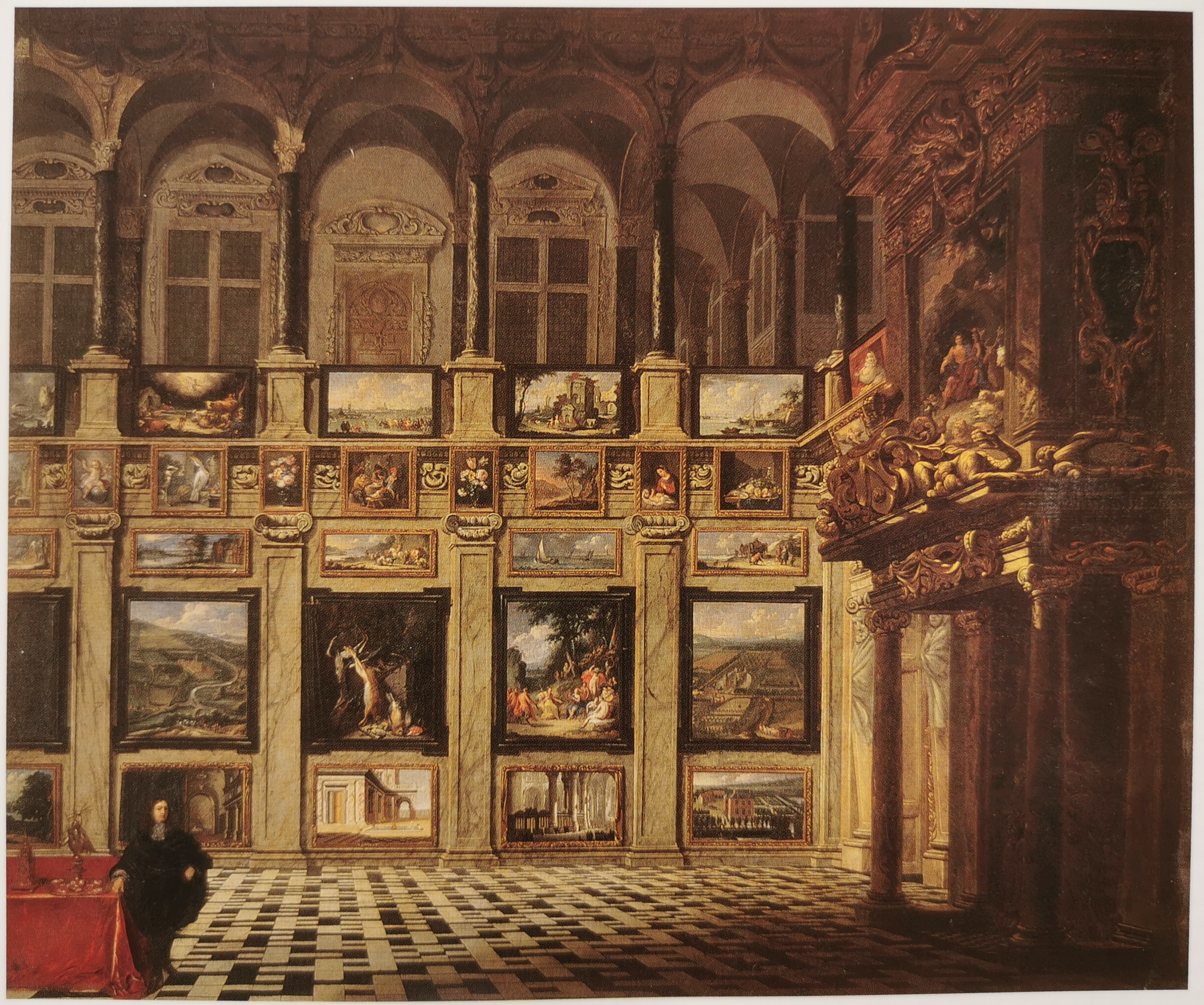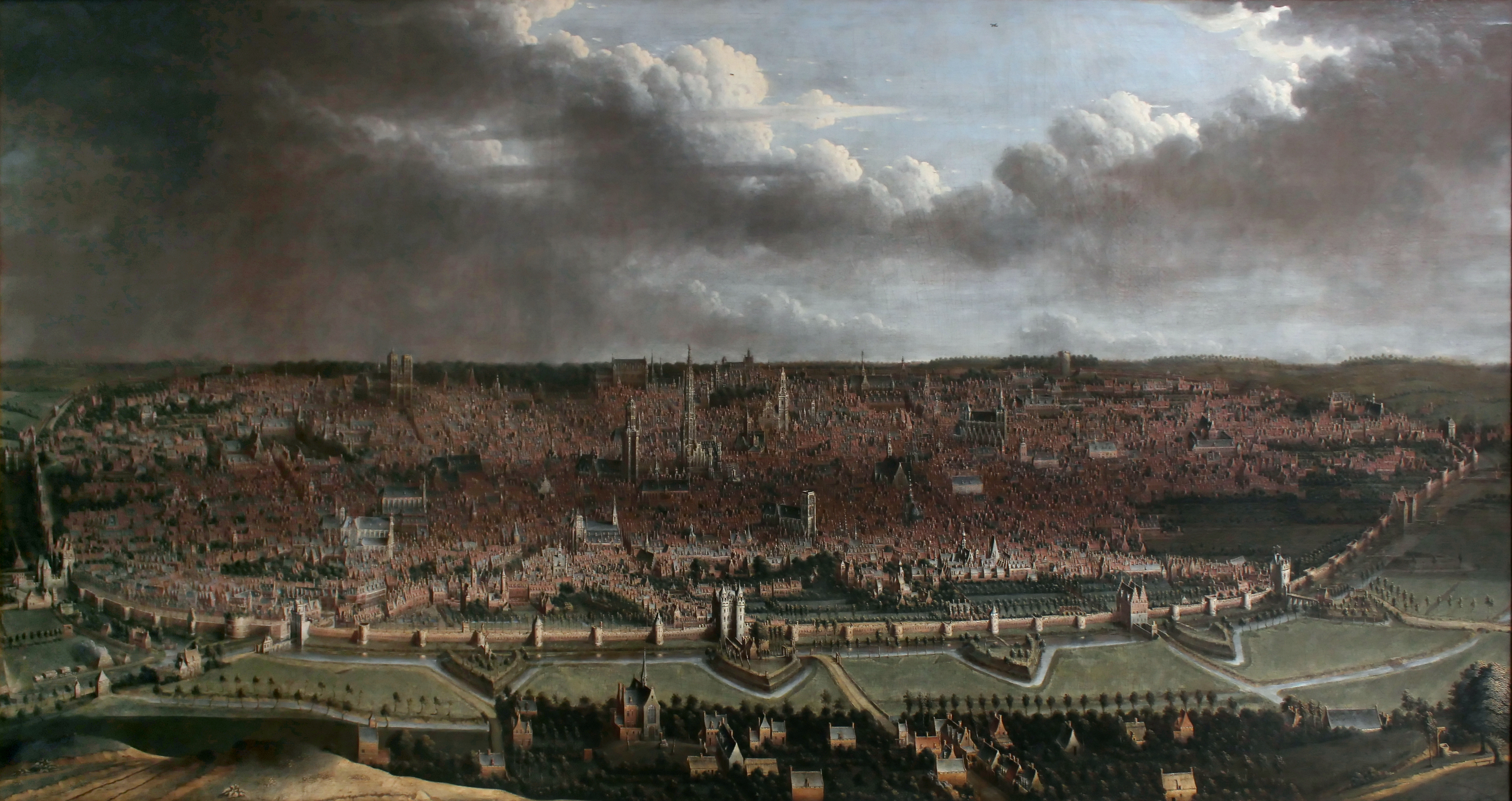|
Granvelle Palace, Brussels
The Granvelle Palace (; ) was a 16th-century Renaissance palace in Brussels, Belgium. It was originally built for Cardinal Archbishop Antoine Perrenot de Granvelle and was located in the former Putterie/Putterij district, between the / and the /, near today's Brussels-Central railway station. The deeply redesigned Granvelle Palace served as the main seat of the Free University of Brussels between 1842 and 1928. It was demolished in 1931 to make way for the North–South connection, a major railway link through central Brussels. The was built on its site. History The Palace of Granvelle The Granvelle Palace was built around 1550 as the sumptuous residence of Cardinal Archbishop Antoine Perrenot de Granvelle. Granvelle acquired two existing '' hôtels particuliers'' there in 1549–50 and had them merged into one of the earliest and most beautiful manifestation of High Renaissance in the Southern Netherlands. The name of the architect is not documented, but it is usually assu ... [...More Info...] [...Related Items...] OR: [Wikipedia] [Google] [Baidu] |
City Of Brussels
The City of Brussels is the largest List of municipalities of the Brussels-Capital Region, municipality and historical City centre, centre of the Brussels, Brussels-Capital Region, as well as the capital of the French Community of Belgium, the Flemish Region (from which it is List of capitals outside the territories they serve, separate) and Belgium. The City of Brussels is also the administrative centre of the European Union, as it hosts a number of principal Institutions of the European Union, EU institutions in its Brussels and the European Union#European Quarter, European Quarter. Besides the central historic town located within the Pentagon (Brussels), Pentagon, the City of Brussels covers some of the city's immediate outskirts within the greater Brussels-Capital Region, namely the former municipalities of Haren, Belgium, Haren, Laeken, and Neder-Over-Heembeek to the north, as well as the Avenue Louise, Avenue Louise/Louizalaan and the Bois de la Cambre, Bois de la Cambre/ ... [...More Info...] [...Related Items...] OR: [Wikipedia] [Google] [Baidu] |
Giacomo Barozzi Da Vignola
Giacomo Barozzi da Vignola ( , , ; 1 October 15077 July 1573), often simply called Vignola, was one of the great Italian architects of 16th century Mannerism. His two great masterpieces are the Villa Farnese at Caprarola and the Jesuits' Church of the Gesù in Rome. The three architects who spread the Italian Renaissance style throughout Western Europe are Vignola, Serlio and Palladio. He is often considered the most important architect in Rome in the Mannerist era. Biography Jacopo Barozzi was born at Vignola, near Modena (Emilia-Romagna). He began his career as an architect in Bologna, supporting himself by painting and making perspective templates for inlay craftsmen. He made his first trip to Rome in 1536 to make measured drawings of Roman temples, with a thought to publish an illustrated Vitruvius. Then François I called him to Fontainebleau, where he spent the years 1541–1543. Here he probably met his fellow Bolognese, the architect Sebastiano Serlio and the ... [...More Info...] [...Related Items...] OR: [Wikipedia] [Google] [Baidu] |
Fernando Álvarez De Toledo, 3rd Duke Of Alba
Fernando Álvarez de Toledo y Pimentel, 3rd Duke of Alba (29 October 150711 December 1582), known as the Grand Duke of Alba (, ) in Spain and Portugal and as the Iron Duke () or shortly 'Alva' in the Netherlands, was a Spaniards, Spanish nobleman, general and statesman. He has often been considered the most effective general (rank), general of his generation, as well as one of the greatest in history. Historian John Lothrop Motley wrote of him "no man had studied military science more deeply, or practiced it more constantly" at his day. He was a royal promoter of military action against Kingdom of France, France and Protestantism, although he also defended a moral and strategic alliance with Kingdom of England, England that never realized. Alba achieved notoriety for his role during the Eighty Years' War in the Spanish Netherlands, where his prolonged campaigns and repressive political actions caused his figure to be reviled in European history as a symbol of Tyrant, tyranny. Bo ... [...More Info...] [...Related Items...] OR: [Wikipedia] [Google] [Baidu] |
Provost (military Police)
Provosts (usually pronounced "provo" in this context) are military police (MP) whose duties are policing solely within the armed forces of a country, as opposed to gendarmerie duties in the civilian population. However, many countries use their gendarmerie for provost duties. As with all official terms, some countries have specific official terminology which differs from the exact linguistic meaning. The head of the military police is commonly referred to as the provost marshal, an ancient title originally given to an officer whose duty was to ensure that an army did no harm to the citizenry. Military police are concerned with law enforcement (including criminal investigation) on military property and concerning military personnel, installation security, close personal protection of senior military officers, management of Prisoner of war, prisoners of war, management of military prisons, Road traffic control, traffic control, route signing and resupply route management. Not all m ... [...More Info...] [...Related Items...] OR: [Wikipedia] [Google] [Baidu] |
Margaret Of Parma
Margaret (; 5 July 1522 – 18 January 1586) was Duchess of Parma from 1547 to 1586 as the wife of Duke Ottavio Farnese and Governor of the Habsburg Netherlands from 1559 to 1567 and from 1578 to 1582. She was the illegitimate daughter of Charles V, Holy Roman Emperor, and Johanna Maria van der Gheynst. She had briefly been Duchess of Florence from 1536 to 1537 by her first marriage to Alessandro de' Medici, Duke of Florence. Biography Margaret's mother, Johanna Maria van der Gheynst, a servant of Count Charles de Lalaing, Seigneur de Montigny, was a Fleming. Margaret was brought up in Mechelen, under the supervision of two powerful Spanish and Austrian Habsburg Imperial family relatives, her great-aunt, the Archduchess Margaret of Austria, and her aunt Mary of Austria, who were successive governors of the Habsburg Netherlands from 1507 to 1530 and from 1530 to 1555, respectively. Her early life followed a strict routine set forth by her father, Charles V, who us ... [...More Info...] [...Related Items...] OR: [Wikipedia] [Google] [Baidu] |
Regent
In a monarchy, a regent () is a person appointed to govern a state because the actual monarch is a minor, absent, incapacitated or unable to discharge their powers and duties, or the throne is vacant and a new monarch has not yet been determined. The rule of a regent or regents is called a regency. A regent or regency council may be formed ''ad hoc'' or in accordance with a constitutional rule. ''Regent'' is sometimes a formal title granted to a monarch's most trusted advisor or personal assistant. If the regent is holding the position due to their being in the line of succession, the compound term '' prince regent'' is often used; if the regent of a minor is their mother, and she is wife or widow of the king, she would be referred to as ''queen regent''. If the formally appointed regent is unavailable or cannot serve on a temporary basis, a may be appointed to fill the gap. In a monarchy, a regent usually governs due to one of these reasons, but may also be elected to ... [...More Info...] [...Related Items...] OR: [Wikipedia] [Google] [Baidu] |
High Nobility
Traditional rank amongst European imperiality, royalty, peers, and nobility is rooted in Late Antiquity and the Middle Ages. Although they vary over time and among geographic regions (for example, one region's prince might be equal to another's grand duke), the following is a reasonably comprehensive list that provides information on both general ranks and specific differences. Distinction should be made between reigning (or formerly reigning) families and the nobility – the latter being a social class subject to and created by the former. Sovereign * The word ''monarch'' is derived from the Greek , ''monárkhēs'', "sole ruler" (from , ''mónos'', "single" or "sole", and , ''árkhōn'', "archon", "leader", "ruler", "chief", the word being the present participle of the verb , ''árkhein'', "to rule", "to lead", this from the noun , ''arkhē'', "beginning", "authority", "principle") through the Latinized form . * The word ''sovereign'' is derived from the Latin ("above"). ... [...More Info...] [...Related Items...] OR: [Wikipedia] [Google] [Baidu] |
Philip II Of Spain
Philip II (21 May 152713 September 1598), sometimes known in Spain as Philip the Prudent (), was King of Spain from 1556, King of Portugal from 1580, and King of Naples and List of Sicilian monarchs, Sicily from 1554 until his death in 1598. He was also ''jure uxoris'' King of England and List of Irish monarchs, Ireland from Wedding of Mary I of England and Philip of Spain, his marriage to Queen Mary I in 1554 until her death in 1558. Further, he was Duke of Milan from 1540. From 1555, he was Lord of the Seventeen Provinces of the Habsburg Netherlands, Netherlands. The son of Emperor Charles V and Isabella of Portugal, Holy Roman Empress, Isabella of Portugal, Philip inherited his father's Spanish Empire in 1556, and succeeded to the Kingdom of Portugal, Portuguese throne in 1580 following a dynastic crisis. The Spanish conquests Spanish conquest of the Inca Empire, of the Inca Empire and of the Philippines, named in his honor by Ruy López de Villalobos, were completed during h ... [...More Info...] [...Related Items...] OR: [Wikipedia] [Google] [Baidu] |
Apollo
Apollo is one of the Twelve Olympians, Olympian deities in Ancient Greek religion, ancient Greek and Ancient Roman religion, Roman religion and Greek mythology, Greek and Roman mythology. Apollo has been recognized as a god of archery, music and dance, truth and prophecy, healing and diseases, the Sun and light, poetry, and more. One of the most important and complex of the Greek gods, he is the son of Zeus and Leto, and the twin brother of Artemis, goddess of the hunt. He is considered to be the most beautiful god and is represented as the ideal of the ''kouros'' (ephebe, or a beardless, athletic youth). Apollo is known in Greek-influenced Etruscan mythology as ''Apulu''. As the patron deity of Delphi (''Apollo Pythios''), Apollo is an oracular god—the prophetic deity of the Pythia, Delphic Oracle and also the deity of ritual purification. His oracles were often consulted for guidance in various matters. He was in general seen as the god who affords help and wards off e ... [...More Info...] [...Related Items...] OR: [Wikipedia] [Google] [Baidu] |
Cupid
In classical mythology, Cupid ( , meaning "passionate desire") is the god of desire, erotic love, attraction and affection. He is often portrayed as the son of the love goddess Venus and the god of war Mars. He is also known as Amor (Latin: ', "love"). His Greek counterpart is Eros.''Larousse Desk Reference Encyclopedia'', The Book People, Haydock, 1995, p. 215. Although Eros is generally portrayed as a slender winged youth in Classical Greek art, during the Hellenistic period, he was increasingly portrayed as a chubby boy. During this time, his iconography acquired the bow and arrow that represent his source of power: a person, or even a deity, who is shot by Cupid's arrow is filled with uncontrollable desire. In myths, Cupid is a minor character who serves mostly to set the plot in motion. He is a main character only in the tale of Cupid and Psyche, when wounded by his own weapons, he experiences the ordeal of love. Although other extended stories are not told about hi ... [...More Info...] [...Related Items...] OR: [Wikipedia] [Google] [Baidu] |
Venus (mythology)
Venus (; ) is a Roman goddess whose functions encompass love, beauty, desire, sex, fertility, prosperity, and victory. In Roman mythology, she was the ancestor of the Roman people through her son, Aeneas, who survived the fall of Troy and fled to Italy. Julius Caesar claimed her as his ancestor. Venus was central to many religious festivals, and was revered in Roman religion under numerous cult titles. The Romans adapted the myths and iconography of her Greek counterpart Aphrodite for Roman art and Latin literature. In the later classical tradition of the West, Venus became one of the most widely referenced deities of Greco-Roman mythology as the embodiment of love and sexuality. As such, she is usually depicted nude. Etymology The Latin theonym and the common noun ('love, charm') stem from a Proto-Italic form reconstructed as ''*wenos-'' ('desire'), itself from Proto-Indo-European (PIE) ' ('desire'; cf. Messapic , Old Indic 'desire'). Derivatives include ''venust ... [...More Info...] [...Related Items...] OR: [Wikipedia] [Google] [Baidu] |
Herb
Herbs are a widely distributed and widespread group of plants, excluding vegetables, with savory or aromatic properties that are used for flavoring and garnishing food, for medicinal purposes, or for fragrances. Culinary use typically distinguishes herbs from spices. ''Herbs'' generally refers to the leafy green or flowering parts of a plant (either fresh or dried), while ''spices'' are usually dried and produced from other parts of the plant, including seeds, bark, roots and fruits. Herbs have a variety of uses including culinary, medicinal, aromatic and in some cases, spiritual. General usage of the term "herb" differs between culinary herbs and medicinal herbs; in medicinal or spiritual use, any parts of the plant might be considered "herbs", including leaves, roots, flowers, seeds, root bark, inner bark (and cambium), resin and pericarp. The word "herb" is pronounced in Commonwealth English, but is standard among American English speakers as well as those from regio ... [...More Info...] [...Related Items...] OR: [Wikipedia] [Google] [Baidu] |










